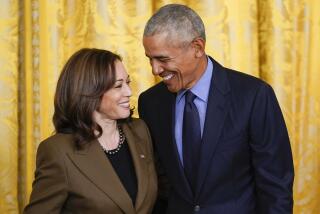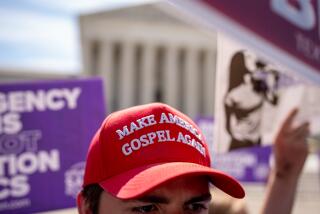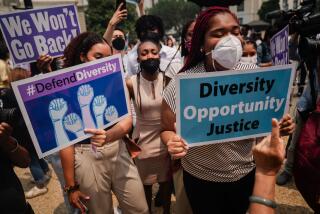Testing Obamaâs effect on racial attitudes
TALLAHASSEE, FLA. â After decades of exposure to all of those stereotypes -- the Aunt Jemimas and the gangsta rappers, the Willie Hortons and TV drug dealers -- this just wasnât supposed to be happening.
The test results baffled Florida State University psychologist Ashby Plant. She checked and rechecked the figures. Something must be wrong, she told herself.
Plant and her colleagues had just administered a racial Implicit Association Test to 74 white college students. A common tool in psychology lab work, the IAT purports to measure the kinds of biases people may not admit or even know they harbor. It is one of the more troubling, and fascinating, realities in Plantâs line of work that when the test is administered to whites, about 75% typically show some degree of anti-black bias.
But in this case, her subjects were displaying almost no bias against African Americans. In fact, about 45% appeared to be favoring blacks over whites.
âIt made us stop dead in our tracks,â she said. âI mean, this was unheard of.â
It was spring 2008 -- a moment of mounting intensity in Americaâs presidential race. It was also the moment when Plant, 40, found herself delving into a new sub-specialty with few precedents in the social sciences.
Call it Obama Studies.
It is a line of inquiry pursued by a small group of researchers, most of them experts in the nature of bias and prejudice. Their goal is to bring some scientific rigor to vexing questions that continue to ricochet around American dining rooms, the kind that were only amplified this summer with the arrest of Harvard professor Henry Louis Gates Jr., who is black: How are racial attitudes changing, if at all, in the age of the first black president?
Plant and her colleagues began speculating that their surprising numbers had something to do with the candidate Barack Obama. After all, his image was everywhere. Perhaps, they would later write in the Journal of Experimental Social Psychology, the students had been profoundly affected by repeated exposure to a man âwhose qualities -- well-educated, motivated, articulate -- contradict the negative stereotypes of African Americans.â
So they began designing an experiment to test their hypothesis.
Serious scientific inquiry into the nature of prejudice has largely been the domain of social psychologists, who study the way people interact with, think about and influence one another.
In the United States, the discipline began gathering steam after World War II, as German emigres sought to better understand the allure of Nazism. The latter half of the 20th century -- with its litany of cruelties, ethnic clashes and minority rights movements -- ensured that the burgeoning field would be strongly influenced by the course of history.
âWe studied aggression after the riots of the 1960s, and we studied gender prejudice as the feminist movement was catching on in the 1970s,â said David G. Myers, a social psychologist at Hope College in Michigan.
It is a discipline that tends to focus on big-picture questions (e.g., âWhat are the motivational sources of prejudice?â) and hyper-specific biological observations (e.g., the role of certain brain regions in race-based fear responses). But with Obamaâs victory -- in a country where, 50 years ago, nearly half of white voters wouldnât consider voting for a black candidate -- a number of researchers now have turned their attention to the influence of one man.
Thus far, some of the most widely discussed test results have been contradictory. If there has been an âObama effectâ on racial consciousness, itâs not clear yet what it is.
Ray Friedman, a management professor at Vanderbilt University, conducted studies that suggested exposure to Obamaâs convention speech and election helped black students close an achievement gap with whites on a verbal aptitude test.
But in another study, a New York University researcher, Joshua Aronson, found that thinking about Obama had no discernible effect on black studentsâ test scores.
At Stanford University, researchers led by graduate student Daniel Effron found what might be called a reverse Obama effect. In their studies, white Obama supporters showed favoritism for whites over blacks in certain hypothetical situations -- perhaps because by supporting Obama, they felt bestowed with non-racist âmoral credentialsâ that made them more comfortable siding with fellow whites.
Plant is an animated and friendly woman with inquisitive brown eyes set in an open, thoughtful face. It is also a white face, and some of her memories growing up in Baltimore involve unpleasant encounters with the realities of race -- like the awkwardness of watching a stereotype-riddled TV show with her black best friend.
Over her years as a social psychologist, she has corralled hundreds of undergraduates and other volunteers into various university psychology labs to be virtually plumbed and prodded. The work, she argues, has real-world relevance: One of her recent studies, for instance, found that in severe emergency situations, whites were slower to help blacks than other whites.
Last year, she enthusiastically supported Obama for president -- although, she said, âhaving studied prejudice for so long, I have to admit that at times I doubted it could happen.â
To determine if Obama had accounted for a true change of mind, Plant and her main collaborator, University of Wisconsin psychologist Patricia G. Devine, would have to overcome a problem that has shaped the course of their field more than any other in recent years: How to record peopleâs racial attitudes when it has become taboo to openly voice prejudices?
One key tool is the Implicit Association Test. Developed in 1998 by University of Washington psychologist Anthony Greenwald and two other researchers, the test is still controversial among some scientists who question whether it can accurately measure such subtleties of thought.
The IAT puts participants in front of a computer, where they are prompted to press keys that correspond with words and faces that flash in front of them: the E key, say, for âwhite,â and the I key for âblack.â Then they are asked to use the same keys to sort positive words, like ârainbow,â from negative ones, like âvomit.â The program mixes up the faces and the words: now, one key must be used to choose, say, both âblackâ and âgood,â and the other to choose both âwhiteâ and âbad.â
The categories are then switched around in various combinations for more rounds of sorting. Meanwhile, a program measures how quickly the test-takers associate the positive or negative words with the black or white faces.
When the users consistently show hesitation in matching, say, black faces with positive words or whites with negative words, believers in the test see the possible work of powerful, unconscious forces. Whether we like it or not, they argue, the mind sometimes struggles to make certain associations.
They are biases to which minorities themselves are not immune: In studies involving thousands of test participants on the Internet, about 40% of blacks showed an anti-black bias, and roughly 1 in 3 Muslims showed an anti-Muslim bias, said Brian Nosek, a University of Virginia researcher who runs Project Implicit, the ongoing Web project.
Plant and her team didnât think they could show that Obama was the sole cause of reduced bias -- it would be difficult to isolate his influence, given all of the stimuli out in the world. But the researchers thought they might be able to at least show a correlation by devising a two-part test.
In the first part, 229 University of Wisconsin students, all nonblack, were given Implicit Association Tests, then asked, among other things, to list five thoughts that came to mind when they considered black people.
Once again, the students, as a group, failed to show much anti-black bias.
Researchers then noted if the participants listed any âpositive black exemplarsâ -- for instance, Obama, Martin Luther King Jr. or Rosa Parks. They found that students who listed a positive exemplar showed less bias on the IAT.
That alone was interesting, but was Obama the one reducing the bias scores? That required navigating around a big problem: âHow do you know that somebodyâs thinking of Barack Obama when theyâre exposed to black people,â said Plant, âwithout explicitly asking about Barack Obama?â
Their solution was to call in 79 nonblack students for an experiment at Florida State. They too were given an IAT. Separately, the researchers exposed them, subliminally, to the words âblackâ and âwhiteâ by flashing them on a computer screen for 55 milliseconds each. (The effectiveness of such subliminal âprimingâ in advertising remains in question, but psychologists have used it effectively to influence peopleâs responses in lab settings for decades.)
The students then were shown a succession of letter groupings, some real words and some nonsense strings of letters, and asked to pick out the real words. Some of the words were crime-related. Other words were government-related, such as âpoliticianâ or âpresident.â
This exercise would test how quickly the students were able, when primed with the word âblack,â to pick out the positive, government-style words, as compared with the negative words.
The researchers compared the results of the subliminal exercise to the IAT results. In essence: Those who responded more quickly to government-related words when primed with the word âblackâ also showed lower implicit prejudice.
The researchers concluded that Obamaâs rise seemed to have influenced âthe underlying associations at least some people carry around in their minds about black people.â
They also warned against drawing âoverly strong conclusions,â and, in fact, Nosek, the psychologist who co-manages Project Implicit, said an analysis of 479,000 people tested online in recent months showed little evidence of changes in bias that can be attributed to Obama. Still, Nosek said, he expects that the first black president will change Americansâ deepest racial attitudes. âItâs just that we donât know yet what those changes will be,â he said.
Despite the conflicting conclusions, Plant believes she is on to something -- so much so that she is now trying to determine if she can design a study that would isolate Obama as the cause of lowered bias.
Its design has consumed Plant and her research assistants much of the summer. In late June they gathered in a conference room in Florida Stateâs psychology building to see where they stood.
Plant nodded to graduate student Corey Columb, 23, who sat across the table. âThe idea Corey had -- an idea which I think is very clever -- is to temporarily undo the [Obama] effect,â Plant said. âYou could, in a sense, reset people to where they might have been before their exposure to him. Then, possibly, expose people to him again.â
In other words: since they assume that Obama has inoculated people against bias, they hoped to temporarily reinfect a few volunteers. Then they would reintroduce half of them to images of Obama, to see if he could cure them.
But what black image could serve, for these purposes, as the anti-Obama?
âThe ones weâve come up with so far that would be relevant to the generation here at the university would be O.J. Simpson and Mike Tyson,â Columb said, though he added that they were struggling. Would students know Simpson? And wasnât Mike Tyson sort of rehabilitating his image?
They left the matter unsettled. A new round of experiments will start later this year. At the same time, Plantâs Wisconsin colleagues will begin calling in groups of students each week to ask them about Obamaâs performance and administer the IAT.
After all, there are endless opportunities for a president to become entangled in scandal or escalate racial tension. The anti-Obama could always turn out to be Obama himself.
--
--
(BEGIN TEXT OF INFOBOX)
How biased are you?
Developed in 1998, the Implicit Association Test seeks to measure the subconscious or âimplicitâ biases that people may not admit, or even know, they harbor.
Critics say its methods -- which involve measuring the takerâs ability to rapidly categorize words and images -- cannot begin to describe the complex and nebulous sentiments that trigger bias and prejudice. Its designers say it offers insights into how people perceive others.
You can take several tests online -- including one focusing on race -- by visiting: https://implicit.harvard.edu/implicit/demo/.
Your results, though anonymous, will be compiled with millions of others as part of a database for psychologists to rely on in their ongoing study of bias and prejudice.
--
Source: Times research






